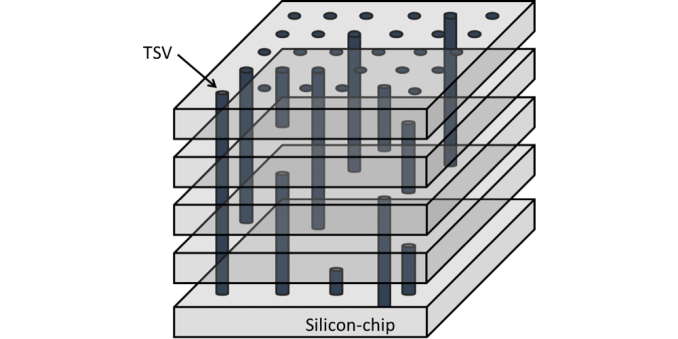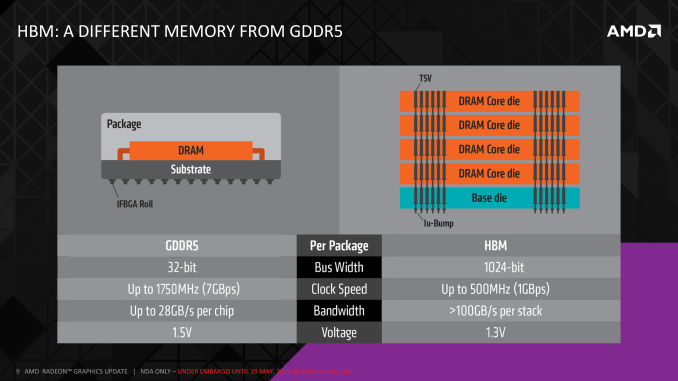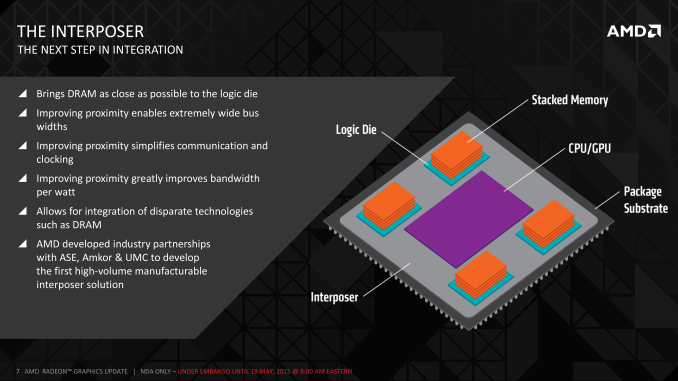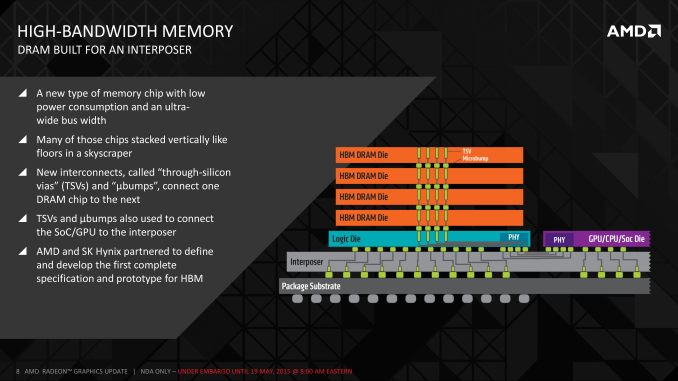AMD Dives Deep On High Bandwidth Memory - What Will HBM Bring AMD?
by Ryan Smith on May 19, 2015 8:40 AM ESTHBM: Wide & Slow Makes It Fast
Given the challenges faced in pushing GDDR5 and similar memory technologies even further, development of high bandwidth memory technology has in the last decade shifted back towards wider, slower interfaces. As serial interfaces reach their limits, parallel interfaces become an increasingly viable alternative. And although they bring with them their own challenges – there’s a reason serial interfaces have been dominant most recently, after all – the ramp up of challenges in further improving serial interfaces has coincided with the development of technologies that make parallel interfaces easier to implement. As a result the pendulum has swung back to parallel interfaces and HBM.
HBM in a nutshell takes the wide & slow paradigm to its fullest. Rather than building an array of high speed chips around an ASIC to deliver 7Gbps+ per pin over a 256/384/512-bit memory bus, HBM at its most basic level involves turning memory clockspeeds way down – to just 1Gbps per pin – but in exchange making the memory bus much wider. How wide? That depends on the implementation and generation of the specification, but the examples AMD has been showcasing so far have involved 4 HBM devices (stacks), each featuring a 1024-bit wide memory bus, combining for a massive 4096-bit memory bus. It may not be clocked high, but when it’s that wide, it doesn’t need to be.
Of course while extra memory bandwidth is nice, the far more interesting part is how HBM delivers this. Although the idea of a wide, slow parallel bus is easy enough to comprehend on paper, implementing it is a whole other matter. A 4096-bit memory bus involves thousands of traces, far more than GDDR5, all of which must be carefully constructed in order to make HBM work. As a result there are a couple of fundamental technologies that are seeing their big (though not necessarily initial) introduction with HBM.
The first and most fundamental matter is how do you efficiently route a 4096-bit memory bus? Even the best surface mounting BGA technologies have their limits, and as it is Hawaii was pushing things with its 512-bit GDDR5 memory bus. An even wider bus only makes that harder, inviting issues both with the routing such a wide bus on a PCB or chip substrate, and in using BGA to connect a chip to those traces.
First part of the solution to that in turn was to develop something capable of greater density routing, and that something was the silicon interposer. The interposer in its broadest terms is a partially fabbed silicon chip that instead of being developed into a full ASIC packed with logic, is only developed as far as having metal layers, in order to route signals and power among devices. The interposer in turn works because it exploits some of the core advantages of modern photolithographic processes, allowing for very fine paths to be created that would otherwise not be possible/practical on traditional PCBs and substrates.
Using a silicon interposer solves some of the fundamental problems with HBM, but it also provides some ancillary benefits as well. Along with solving the obvious routing issue, the interposer allows for DRAM to be placed very close to an ASIC, but without being placed on top of it (ala Package-on-package), which is impractical for high TDP devices like GPUs. By being able to place DRAM so close to the ASIC, it avoids the drawbacks of long memory paths, making the shorter paths both simpler to construct and require less power in the process. It also benefits integration, as similar to PoP technology, you can have more of the device’s functionality located on the same package as the ASIC, reducing the number of devices that need to be placed off-package and routed to the ASIC.
Of course the interposer does come with a drawback as well, and that’s cost. While AMD is not talking about costs in great detail – this is a technology deep dive, not an analyst meeting – the fact that the interposer is essentially a very large, partially developed silicon chip means that it’s relatively expensive to produce, especially compared to the very low costs of PCBs and traditional substrates. Mitigating this is the fact that interposers don’t need to go through the most complex and expensive phases of photolithography – the actual front-end lithography – so the cost is only the silicon wafer itself, along with the work required to create the metal layers, with the final interposer only being some 100 microns thick. Furthermore this doesn’t require cutting-edge fabs – old, fully amortized 65nm equipment works quite well – which further keeps the costs down. The end result is that the interposer is still a significant cost, but it is not as bad as it initially seems. This ultimately is why HBM will first be introduced on high margin products like high-end video cards before potentially making its way down to cheaper devices like APUs.
Meanwhile AMD and their vendors will over the long run also benefit from volume production. The first interposers are being produced on retooled 65nm lithographic lines, however once volume production scales up, it will become economical to develop interposer-only lines that are cheaper to operate since they don’t need the ability to offer full lithography as well. Where that cut-off will be is not quite clear at this time, though it sounds like it will happen sooner than later.
Looking at the broader picture, in the grand scheme of things the interposer becomes a new layer on a complete chip, sitting between the traditional substrate and any DRAM/ASICs mounted on top of it. Microbumps will connect the DRAM and ASICs to the interposer, and the interposer will then be connected to the substrate, before finally the substrate is connected to its partner PCB. PCB mounting itself will become a bit easier in the process, as there’s no longer a need to route memory traces through the substrate, which means the only remaining connections are data (PCIe bus, etc) and power for the ASIC and DRAM. All the complex routing is essentially localized to occurring at the interposer layer.
Moving on, the other major technological breakthrough here is the creation of through-silicon vias (TSVs). With the interposer to enable the routing of a dense memory bus, the other issue to solve was the creation of dense memory. The solution to this was to stack multiple memory dies together into a single device/stack, in order to create the single 1024-bit stack, and TSVs are in turn what make this possible.
The reason for stacking DRAM is pretty straightforward: it makes production easier by reducing the DRAM to fewer discrete devices, not to mention it saves space. The challenge here is that you can’t have traditional surface mount connections since the DRAM is stacked, and traditional edge connections (as used in PoP) are neither dense enough nor do they scale well to the kind of stacks HBM would require.

TSVs. Image Courtesy The International Center for Materials Nanoarchitectonics
As a result a means was needed to route DRAM connections though the lower layers of the stack, and this problem was solved with TSVs. Whereas regular vias offer the ability to connect two layers together, TSVs extend this principle by running the vias straight through silicon devices in order to connect layers farther out. The end result is something vaguely akin to DRAM dies surface mounted on top of each other via microbumps, but with the ability to communicate through the layers. From a manufacturing standpoint, between the silicon interposer and TSVs, TSVs are the more difficult technology to master as it essentially combines all the challenges of DRAM fabbing with the challenges of stacking those DRAM dies on top of each other.
Having developed the means to stack DRAM, the final component of an HBM stack is a logic die that lies on the bottom of the stack. Similarly outfitted with TSVs, the logic die is responsible for actually operating the DRAM dies above it, and then handling the operation of the HBM bus between the stack and the ASIC. This actually ends up being a rather interesting development since the net result is more logic added despite the simplicity of the HBM bus, but at the same time thanks to TSVs and the interposer, it’s easier than ever to add that logic.













163 Comments
View All Comments
chizow - Wednesday, May 20, 2015 - link
Wouldn't be the first time David Kanter was wrong, certainly won't be the last. Still waiting for him to recant his nonsense article about PhysX lacking SSE and only supporting x87. But I guess that's why he's David Kanter and not David ReKanter.Poisoner - Friday, June 12, 2015 - link
You're just making up stuff. No way Fiji is just two Tonga chips stuck together. My guess is your identity is wrapped up in nVidia so you need to spread fud.close - Tuesday, May 19, 2015 - link
That will be motivation enough to really improve on the chip for the next generation(s), not just rebrand it. Because to be honest very, very few people need 6 or 8GB on a consumer card today. It's so prohibitively expensive that you'd just have an experiment like the $3000 (now just $1600) 12GB Titan Z.The fact that a select few can or would buy such a graphics card doesn't justify the costs that go into building such a chip, costs that would trickle down into the mainstream. No point in asking 99% of potential buyers to pay more to cover the development of features they'd never use. Like a wider bus, a denser interposer, or whatever else is involved in doubling the possible amount of memory.
chizow - Tuesday, May 19, 2015 - link
Idk, I do think 6 and 8GB will be the sweet spot for any "high-end" card. 4GB will certainly be good for 1080p, but if you want to run 1440p or higher and have the GPU grunt to push it, that will feel restrictive, imo.As for the expense, I agree its a little bit crazy how much RAM they are packing on these parts. 4GB on the 970 I thought was pretty crazy at $330 when it launched, but now AMD is forced to sell their custom 8GB 290X for only around $350-360 and there's more recent rumors that Hawaii is going to be rebranded again for R9 300 desktop with a standard 8GB. How much are they going to ask for it is the question, because that's a lot of RAM to put on a card that sells for maybe $400 tops.
silverblue - Tuesday, May 19, 2015 - link
...plus the extra 30-ish watts of power just for having that extra 4GB. I can see why higher capacity cards had slightly nerfed clock speeds.przemo_li - Thursday, May 21, 2015 - link
VR.It require 90Hz 1090p x2 if one assume graphics same as current get non-VR graphics!
That is lots of data to push to and from GPU.
robinspi - Tuesday, May 19, 2015 - link
Wrong. They will be using a dual link interposer, making it instead of 4GB hi it will be 8GB hi-hi. Read more on WCCFTech:http://wccftech.com/amd-radeon-r9-390x-fiji-xt-8-h...
HighTech4US - Tuesday, May 19, 2015 - link
Wrong.4GB first, 8GB to follow (on dual GPU card)
http://www.fudzilla.com/news/graphics/37790-amd-fi...
chizow - Tuesday, May 19, 2015 - link
Wow lol. That 4GB rumor again. And that X2 rumor again. And $849 price tag for just the single GPU version???! I guess AMD is looking to be rewarded for their efforts with HBM and hitting that ultra-premium tier? I wonder if the market will respond at that asking price if the single-GPU card does only have 4GB.przemo_li - Thursday, May 21, 2015 - link
Artificial number like X GB, wont matter.Artificial number like YZW FPS in games S,X,E will ;)
Do note that Nvidia need to pack lots of GB just for wide bus effect!
It works for them, but games do not require 12GB now, nor in short term future (-- no consoles!)